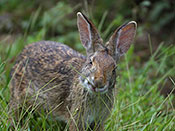Paradise Found Companion Animal Products


Small mammals can make great pets. Mammal companions can provide a unique way to teach children responsibility and care of animals.If you have questions on the perfect home and environment for a gerbil, or are wondering about the nutritional needs of a guinea pig, this section will help answer many of your questions.
Gerbil
These tiny little creatures can be a lot of fun, especially for a first time pet. They are relatively easy to care for and do not require a lot of interaction. They do not take up a lot of space or time, and with the proper care and gentle handling, they may become tame and friendly.
In the wild, gerbils can be found in the deserts of Africa, Asia and China. The gerbil that people are familiar with as a pet is the Mongolian Gerbil. Gerbils are also known as sand rats because they burrow below the sand. Their diet in the wild is based on grains and seeds. Water is scarce for them in their natural habitat, the desert.
Facts –
Order: Rodentia Family: Cricetidae
Genus: Meriones Species: unguiculatus
Sexual Maturity: 8 weeks+ Life Span: 5-10 years
Maximum Adult Size: 15-20 cm w/tail (6-8 inches)
Habitat Size: L x W x H: A minimum of 46 x 25 x 25 cm (18 x 10 x 10 in) w/a tight-fitting cover and 6-8 inches of burrowing material.
Guinea Pig
Guinea Pigs are good pets that are fairly easy to care for. They’ll squeal like a little pig to let you know they are hungry or want attention. Guinea pigs must have a proper amount of Vitamin C in their diets, due to their inability to synthesize it. Any of the Paradise Found Guinea Pig Diets will provide the perfect balance.
Guinea pigs or Cavia porcellus are not known in the wild, but you’ll find domestic guinea pigs worldwide in captivity. It is believed that the Incas in Peru originally domesticated them.
Facts –
Order: Rodentia Family: Caviidae
Genus: Cavia Species: porcellus
Sexual Maturity: 3-5 weeks Life Span: 5-7 years
Maximum Adult Size: Up to 30 cm (12 in)
Habitat Size: L x W x H: 61 x 61 x 61 cm (24 x 24 x 24 in)
Dietary/Nutritional Supplements: Dark leafy greens, such as carrot tops and lettuce
Hamster
Hamsters are pets that prefer to be kept as the soul critter in a habitat; they do not care to share their space with another hamster. Hamsters have cheek pouches where they store their food until they can place it in another spot within their cage. You’ll find it amazing as to how much food they can fit in their cheeks.
In the wild, hamsters are found in the Syrian Arab Republic in dry, rocky or well-shrubbed places. They live singly in burrows and only come together for breeding purposes. Hamsters are omnivorous and are found to eat roots, plants, invertebrates, and carrion.
Facts –
Order: Rodentia Family: Muridae
Genus: Mesocricetus Species: auratus
Sexual Maturity: Females 12 weeks/Males 8 weeks Life Span: 2-3 years
Maximum Adult Size: 13 cm (5in)/ 115g (4 oz)
Habitat Size: L x W x H: 46 x 30 x 30 cm (18 x 12 x 12 in)
Dietary/Nutritional Supplements: Finely chopped fresh fruits, vegetables and cheese
Mouse
Mice are great beginner pets. They are very inexpensive, and their habitat is usually inexpensive. They are easy to care for and do not require a lot of interaction, although some people are surprised at how friendly a mouse can be.
In the wild, we have what are known as field mice or house mice–found all over the world and maybe even in your own home, unwanted. They’ll forage and feed on seeds and grains. They are very agile and skillful with their climbing abilities and able to enter through pencil-size holes.
Facts –
Order: Rodentia Family: Muridae
Genus: Mus Species: Musculus
Sexual Maturity: 6 weeks Life Span: 1-3 years with a 5-year maximum
Maximum Adult Size: 20-40 gm (.04-.08 pounds)
Habitat Size: L x W x H: 15 x 30 x 30 cm (6 x 12 x 12 in)
Rabbit
Rabbits have been popular pets for years. They come in a variety of colors, sizes, fur types, and ear types. From tiny with tiny ears to huge (larger than some small dog breeds) with long ears that touch the ground. Rabbits can be litter-trained and kept just like a pet cat, although chewables must be kept off the ground, especially electrical cords.
The rabbits in the wild are different from the domesticated ones. Rabbits are herbivores, therefore eating various plants in the wild such as grasses, seeds, vegetables, and fruits.
Facts –
Order: Lagomorpha Family: Leporidae
Genus: Oryctolagus Species: cuniculus
Sexual Maturity: 4-7 months Life Span: 6-10 years
Maximum Adult Size: Size varies greatly from diminutive dwarfs to giant breeds
Habitat Size: L x W x H: 91 x 76 x 76 cm (36 x 30 x 30 in)
Rat
Rats are very intelligent creatures that enjoy and need human interaction. They are very social creatures. They are a fun pet that is relatively easy to care for.
In the wild, rats are found all over the world, although there are hundreds of different species of rat. They are a true omnivore; they’ll eat almost anything–meat, vegetables, eggs, grains, nuts, and fruits, etc. They are true opportunists and will scavenge up any food available to them.
Facts –
Order: Rodentia Family: Muridae
Genus: Rattus Species: norvegicus
Sexual Maturity: 1.5-2.5 months Life Span: 2-4 years
Maximum Adult Size: 25-40 cm (10-15 in)
Habitat Size: L x W x H: 51 x 24 x 30 cm (20 x 10 x 12 in)